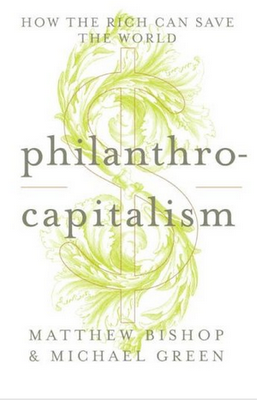Philanthrocapitalism: How the Rich Can Save The World

If the adage about giving a woman a fish only feeding her for a day, but teaching her to fish feeds her for life is true, then Matthew Bishop and Michael Green would argue that the nature of today’s philanthropic giving has taken a similar turn by creating a standard and strategy of giving that doesn’t simply donate—it leverages, it grows, it profits, and it multiplies.
In Philanthrocapitalism, through a series of interviews with notable wealthy donors like Bill and Melinda Gates, Warren Buffet, and even Angelina Jolie, the pair argues that philanthropy has taken on a new shape. Though giving as a trade has been around for sometime (Bishop and Green mark the merchants of Tudor England and Renaissance Europe as among the first philanthropists), they argue today’s new philanthropists were born of an era of highly lucrative capitalism and as a result “are trying to apply the secrets behind that money-making success to their giving,” and earning them the title “Philanthrocapitalists.”
The giving is notable, of course. The authors begin with Warren Buffet’s incredible public donation of more than $37 billion dollars of his fortune, comparing it to the prior year’s $31 billion dollar donation from Bill and Melinda Gates. At stake, the authors argue, for many of these donors, is their challenge to one another to continue to give and to continue to up the ante. The leveraging of funds—positioning dollars to begin or shore up projects and using corporate business sense to keep the money coming and the project growing—is the newest incarnation of giving. The authors argue, it’s new, it’s innovative, and it’s working.
Philanthrocapitalism is a combination tutorial on philanthropy’s history and good works and contemporary business and investing. The constant parallels to solid business stamina and strategy are necessary to explain how contemporary givers are able to do so and in order to highlight the unique ways they donate. It is also, however, a useful tutorial to anyone investing, $37 billion or simply $3,700. The writing style of the authors allows even the algebra apprehensive to understand leveraging practices and money growth. The coupling of business with the heartwarming and important stories of empathy and need also highlight the unending need for donation.
Key also to Philanthrocapitalism, though published in 2008 and its statistics and information necessarily assembled prior to that, is its timing. The current economic downturn is free marketing for Bishop and Green’s overarching argument that in a capitalist framework, the need for philanthropy is unending, necessarily political and is to be counted on as a source of revenue for any number of social programs.
This analysis is highly informative, if not disturbing, because it showcases a capitalist privileging of wealth that isn’t simply about consumerism. The philanthrocapitalists are choosing charities that not only make a difference, but that can be successful and it begs the question: who decides and how do the new definitions of need get crafted? Is it to be based on quarterly reports and evidence of growth? Or is it to be based on tangible human qualities like fed children, cleaner water and savvier school children? If giving is to be a business, who decides what the bottom line should be?